|
On the first anniversary of the
Iroquois Theater fire, newspapers ran stories about commemorative
services held at churches and increased
traffic as families visited cemeteries to mourn
their loved ones.
The graph pictured above mentions cemetery
dispersal of fewer than half the Iroquois Theater victims
and was probably compiled from public inquest records by the
coroner's office.
On the first anniversary, in addition to cemetery and
church visits, six hundred gathered in Willard Hall
at the Women's Temple for a service conducted by the
Iroquois Memorial Association and a smaller group on
the sidewalk and in Randolph street outside the
former Iroquois Theater, by 1904 operating as the
Hyde & Behman. The theater had planned to
operate on December 31, 1904, but public censure
shamed management into closing from noon until 8:30 pm. While street
peddlers hawked paper memorials outside Willard
Hall, inside people sang hymns, shared pictures of
their loved ones and consoled one another.
|
|
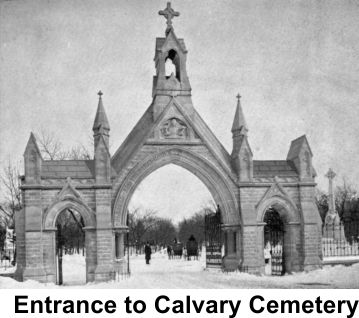
Consecrated in 1859 and affiliated with the Catholic Church, Calvary
Cemetery is north of Chicago on Lake
Michigan in Evanston at 301 Chicago avenue (Clark
St.). Considered full now, it's 20,000
interments include twenty-three Iroquois Theater
victims.
~~~~~~~~~~
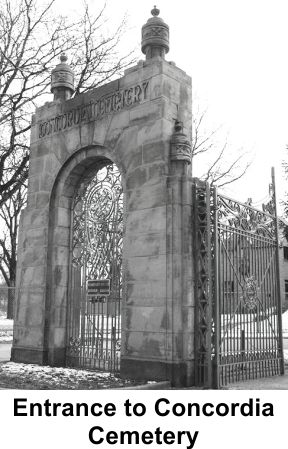
Concordia Cemetery was established in 1872 at 7900 Madison St. in Forest
Park as a 60-acre German Lutheran facility. Today there are over
60,000 interments, of which two are Iroquois Theater victims.
~~~~~~~~~~
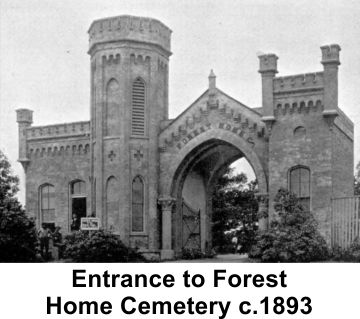
In 1873 there were two
adjacent cemeteries, Waldheim and Forest Home.
They merged in 1969 and are today known as
Forest Home, the official address at 863 Des Plaines
Avenue in Forest Park, a Chicago suburb.
Around thirty Iroquois Theater victim graves are at
Forest Home.
|

|
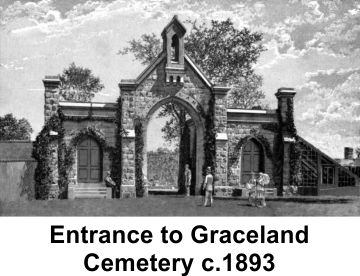
Established in 1860, Graceland Cemetery by 1893 contained 60,000
interments. The cemetery added a hundred
Iroquois Theater victims in January 1904. Located at 4001 N.
Clark, Graceland consists of 119 acres.
Like Rosehill, Graceland boasts many Chicago celebrity
tombs, including Marshall Field, noted architects
David Adler, Louis Sullivan, Ludwig Mies van der
Rohe and Daniel Burnham, Pinkerton Detectives
founder, Allan Pinkerton, and Cyrus McCormick.
~~~~~~~~~~
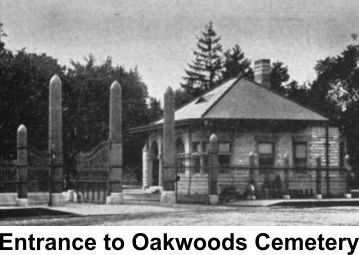
At 184 acres, Oakwoods is
one of Chicago's largest cemeteries (second only to
Rosehill). It is on the north side of the
city at 1035 E 67th street .
Fifty Iroquois Theater fire victims are
interred at Oakwoods, as well as Jessie Bartlett
Davis, wife of Iroquois T heater manager Will J.
Davis. Oakwoods was the site of thousands
of Confederate soldiers who died at Camp Douglas.
~~~~~~~~~~
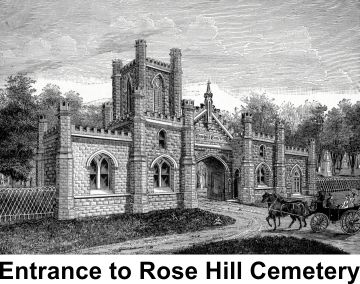
At 350 acres, Rosehill Cemetery at 5800 N. Ravenswood Ave
on Chicago's north side
is the city's largest. At its dedication in 1859 the
city's population was one hundred thousand.
It is the resting place of many
famous Chicago pioneers —
including names familiar in America's homes for
decades, such as Sears, Montgomery Ward and Schwinn — along with
around seventy-five Iroquois Theater victims.
William Boyington designed the ornamental limestone
entrance (as well as the Chicago
Water Tower).
|
|
Five years after the fire,
in conjunction with its annual remembrance services,
the Iroquois Theater Memorial Association dedicated
a granite monument in Montrose Cemetery at 5400 N.
Pulaski northwest of Chicago. The stone marks
the burial site of the last unidentified victim of
the fire as known in 1904, a woman in her fifties, said to have been
viewed by hundreds, recognized by none. She
was interred in June 1904. Kircher donated
the burial plot and the Memorial Association
purchased the stone. Ten years after the fire
a career criminal named Spencer confessed to having
stolen a badly damaged body of an woman in her
twenties, and having it buried with a bogus
name, Nellie Skarupa. His landlady from 1903
came forward and confirmed the funeral and his
involvement. No one came forward to report a
missing woman in her twenties but the family of
Bertha Fellman, an aged woman, petitioned the
court to have her declared dead though her body was
never found. Her daughter-in-law who accompanied her to the theater testified to Bertha's
presence in the theater. Bertha's family most
certainly viewed the body eventually buried as the
Unknown Woman and concluded it was not Bertha.
|

|
If Spencer
buried Bertha as Nellie Skarupa, that could explain the disappearance of
Bertha's remains but there remains one unidentified
body beneath the stone in Montrose Cemetery.
The
miss-identification of Carolina Ludwig's body is
the most promising lead to determining the identity
of the Unknown Woman. If correct, the body is
that of
Ruth Robbin,
Frances Lucile Oakey or
Rosamond P. Parrish.
Many newspapers reporting on the dedication picked up a news agency story that
perpetuated the inaccurate story about a rope from
an aerial ballet performance having prevented the
fire curtain from descending. That inaccuracy
had been thoroughly disproved by much-publicized
courtroom evidence in 1904; clearly, the 1908 report was
penned by someone unfamiliar with the Iroquois fire.
Founded in 1902 by Andrew Kircher,
Montrose Cemetery was new in 1903 and less
established than others in Chicago. Only the
Unknown Woman and one other Iroquois victim are interred there.
Reverend Jenkin Lloyd Jones, Rabbi Tobias Schanfarber and health
commissioner Dr. W. Evans were among the speakers at
the 1908 memorial service at Willard Hall in the
evening after the marker dedication.
|
